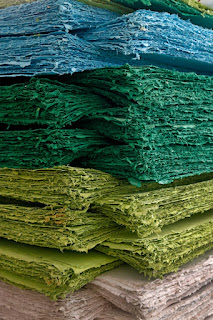One of the most important uses of cellulose is for the manufacturer of paper. The cellulose used is obtained from wood, cotton rags, waste paper, cereal straws, and similar modern method of making paper consists of the following steps.
- Preparation of Wood Pulp;
- Preparation of Paper.
(a) Mechanical Process:- In this process, wood after being barked, is pressed against a rotating stone or a steel pulping wheel in the same manner as grinding an axe against old- fashioned grind stone. As a result of this wood fibres are separated from each other. Water is added to the mill. It cools the pulping wheel and washes the pulb formed into a pot below the wheel.
(b) Sulphite Process:- In this process wood after being barked is cut into smaller chips by mechanical cutters. The chips are then digested with a solution of calcium hydrogen Sulphite and then reduced to pulp mechanically. Lignin, hemicelluloses and resinous substances which are associated with wood are dissolved. Cellulose itself is not attacked in this process. The digesting is done in a steel vessel at a Pressure of about 4 to 6 atmospheres and at a temperature of 150° C for about 10 hours. After the operation is finished the contents of the digester are wasted thoroughly with water and bleached with liquid chlorine or calcium hypochlorite. They are then screened from coarser particles and dewatered by passing them through special filtering machines. The purified pulb is obtained in the from of white plates through special filtering machines. The purified pulb is obtained in the from of white plates through special filtering machines. The purified pulb is obtained in the from of white plates consisting of 89 to 90 per cent cellulose. The pulb produced by this method is known as the Sulphite pulb.
(c) Sulphate Process:- In this process, the cellulose is freed from lignin and other accompanying substances by digesting the wood chips with an aqueous solution of sodium sulphate. The digesting and the processing of the resulting pulb is carried in the same way as described for the Sulphite process. The pulb obtained by this method is known as the Soda pulb or Kraft pulb.
Mechanical pulb is simply ground wood and contains most of the components of wood from which it was made, including lignin and cellulose, paper, such as newsprint, is made from mechanical pulb and can be identified because it turns yellow with an aqueous solution of aniline. This is due to the high lignin content of the mechanical pulb. Sulphite pulb or soda pulb shown no change with same treatment.
(2). Preparation of Paper:- In the manufacturer of paper the purified pulp is mixed with water in a pulp when pulp paste is obtained. Many substances such as clay, rosin, prepare paper's of special properties. For example, rosin and similar material are used as 'sizes' to fill up the spaces between the be cellulose fibres; this prevents ink from spreading on the paper and gives it a smooth finish. Glazed paper contains clay or aluminum Sulphite, and waxed paper contains paraffin.
Pulp paste containing a sizing material is fed on a wire screen carried on an endless belt. This results in dewatered of pulp stock. To aid this process sometimes a suction box is added below the wire screen. When the matter reaches the end of the wire, sufficient water has been removed to make it a consistent mat and to enable it maintains its shape without support.
It is then conveyed by means of belts made of felts through a series of rollers where it is further dewatered and made compact. It is then passed through dries which are made up a series of steam-heated cast iron cylinders. After the drying operation the paper is finished or polished by passing between a number of horizontal, highly polished, chilled cast iron rollers, known as calenders. It horizontal polished chilled cast iron rollers, known as callenders. It is rolled on reels.
If the pulp is made into paper without a sizing material, the product is porous and resembles filter paper. When such a paper is immersed in about 75 per cent sulphuric acid for a short time and then washed with water, the so-called parchment paper is obtained.
Paper Industry in India
The production of paper in India dates back to 1881, when the Titaghur Paper Mills were established in Bengal. During World War II, the number of increased to 15 and the production reached 104,884 tonnes (1944-5). Repid progress has been made since 1950. I'm 1972-73 there were 63 mills producing paper of all varieties and the total production was 825,000 tonnes.










